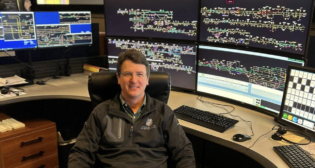
Crawford to Bose: Safety Policy Changes ‘Politically Motivated’
Written by William C. Vantuono, Editor-in-Chief
Rep. Rick Crawford (R-Ark.), Ranking Member, House Transportation & Infrastructure Committee, Subcommittee on Railroads, Pipelines and Hazardous Materials
Editor’s Note: On June 14, 2022, the day that the House Transportation & Infrastructure Committee, Subcommittee on Railroads, Pipelines and Hazardous Materials is conducting a hearing, “Examining Freight Rail Safety,” the purpose of which is “for members to learn about the current state of freight rail safety, in addition to hearing testimony on how to keep rail workers and our rail system safe,” Railway Age received a copy of a June 10, 2022 painstakingly detailed letter to Federal Railroad Administrator Amit Bose from Subcommittee Ranking Member Rick Crawford (R-Ark.) strongly questioning recent FRA “decisions to deny and limit the use and development of ATI (automated track inspection) technology.”
House T&I Republican Communications Director Justin Harclerode provided the letter, commenting that Crawford has “concerns that these changes look politically motivated—not based on safety, as any such changes should be. In fact, ATI has steadily shown safety improvements, so this change in policy just doesn’t seem to make any sense from a safety standpoint. You can expect Crawford to raise this issue at today’s hearing on rail safety.”
Indeed, Crawford raised the issue, stating in opening remarks, “America’s freight railroads rank as one of the safest means of transporting goods in the world. According to the Association of American Railroads, train accidents were down 33% between 2000 and 2020, and accidents involving hazardous materials were down 60%. These gains in safety build toward the ultimate target of zero accidents. Monitoring and protecting our 140,000-mile freight rail network is no easy job. Improving highway-rail grade crossing protections, reducing human error, and supporting innovative new drone and automated safety technologies can all contribute toward reaching the zero-accident goal. Specifically, we must continue to encourage the development of automated track inspection safety technology, which has been shown to decrease accidents, identify new safety issues, and free up safety inspectors to focus on other important duties.”
Following is the full text of Crawford’s letter, with footnotes:
Dear Administrator Bose:
I write to express deep concerns about recent safety policy changes by the Federal Railroad Administration (FRA) [that] likely limit the use of automated track inspection (ATI) technology. FRA’s recent decisions to deny and limit the use and development of ATI technology lack a basis in furthering safety and track inspection improvements and seem politically motivated to appease labor interests.1 For [more than] thirty years, FRA supported the continued growth of automated track inspection technology through FRA’s own Automated Track Inspection Program (ATIP).2 ATIP encourages the use of new technologies to aid in track safety inspections that identify safety issues that visual inspections may miss. Specifically, ATIP “helps America’s railroads improve railroad quality and safety under statutes mandated by Congress.”3 Information collected by ATIP is used by the government and the rail industry to improve railroad safety. As FRA states:
“The track data collected by ATIP is used by FRA, railroad inspectors and railroads to assist and assure track safety is being maintained by setting priorities for their respective compliance activities. Also, the data is used by FRA to assess track safety trends within the industry. Immediately following ATIP track surveys, the railroads use the data to help locate and correct exceptions found. Often, railroads use the ATIP data as a quality assurance check on their track inspection and maintenance programs.”4
Only two years ago, FRA extolled the virtues of research and development of artificial intelligence(AI) such as ATI for improving railroad safety. As an FRA official noted, “[w]ith the use of AI and other technologies, there is great potential for railroads to further reduce the occurrence of high-consequence accidents and derailments altogether. To realize such a future for rail transportation, RD&T is focused on dedicated research initiatives aimed at Improving, Implementing and Inspiring[.]”5
Recognizing the ability of this technology to enhance safety, Class I freight railroads obtained FRA approvals to test the combination of ATI technology and manual track inspections by gradually reducing manual visual inspections required under a 1971 rulemaking.6 Despite this progress, FRA’s recent decisions to stop or limit ATI test programs implemented by BNSF Railway and Norfolk Southern (NS) freight railroads raise troubling questions about FRA’s continued commitment to promotings afety and security technology and the influence of labor groups seeking to protect special interests.7
Regarding BNSF, in 2018 FRA approved an ATI test program specifically “designed to test the use of unmanned autonomous track geometry measurement systems (ATGMS) for track inspection as a viable means to supplement and decrease the frequency of manual visual inspections.”8 On July 28, 2020, BNSF petitioned FRA seeking a regulatory waiver that would allow it to continue its ATI testing.9 FRA published two notices in the Federal Register seeking comments on BNSF’s waiver petition, and received comments from two groups: the Association of State Railroad Safety Managers and the Brotherhood of Maintenance of Way Employees Division/IBT (BMWED). Both opposed granting a waiver to BNSF.10 Nonetheless, on January 19, 2021, FRA generally rejected the claims made by the labor unions and granted BNSF’s petition for waiver, in part, allowing BNSF to continue its ATI waiver for five years.11 In approving BNSF’s petition, FRA itself noted that ATI inspections detect geometry defects “more precisely and accurately than visual inspections” and found that granting the waiver was in the public interest and consistent with railroad safety.12 As recently as November 2021, FRA noted the “successful results of the [BNSF] test program” to Congress and explained that BNSF’s waiver was granted due to cited improvements under the “BNSF track geometry measurement test program based on the established defect metric, FRA monitoring procedures, and consistency of number of defects located by visual track inspection.”13
However, on June 15, 2021, BNSF again petitioned FRA based upon the safety successes occurring under the January 19, 2021, waiver and sought an expansion to two new ATI territories.14 BNSF supplemented this petition with two letters highlighting the improved safety benefits and success of BNSF’s current ATI program as support.15 FRA published notice of BNSF’s petition in the Federal Register, which elicited only one comment, from BMWED. As before, BMWED generally opposed granting the expansion envisioned by the waiver on the grounds that it “does not feel”16 the ATI technology provided an adequate level of safety. On March 22, 2022, FRA found that expansion of the waiver “is not justified,”17 and dismissed BNSF’s petition. Notably, FRA did not dispute ATI’s safety benefits, but merely asserted that an expansion of this test program was allegedly unnecessary since FRA had already collected sufficient data from BNSF to evaluate ATI.18
Like BNSF, Norfolk Southern (NS) filed a petition with FRA on March 22, 2021, seeking a waiver of manual track inspection regulations to permit the pairing of ATI technology with the frequency of manual inspections that successfully demonstrated significant gains in track quality and safety during NS’s test program.19 At the time the waiver petition was filed, NS was completing the final phase of its ATI test program.20 NS noted increased benefits of combining ATI and manual inspections, and reported: “Almost all geometry defects found during the Test Program were discovered by the [ATI] equipment rather than by human inspectors.”21 After waiting [more than] nine months from initial filing of its waiver petition, NS pleaded for FRA action. In a January 6, 2022, letter seeking approval, NS explained “[e]very day that passes without approval of Norfolk Southern’s Petition is another day that safety benefit is not realized anywhere on Norfolk Southern’s system .. ”22 Similar to BNSF’s ATI waiver petitions, BMWED submitted comments opposing the petition, despite admitting the safety benefits of NS’s ATI technology.23 In defiance of FRA regulations requiring the FRA Safety Board to decide waiver petitions within nine months, FRA denied NS’s petition a full year later, citing excuses similar to those used in denial of BNSF’s petition.24
FRA’s decisions to discourage the continued use and expansion of proven ATI safety technology deny the demonstrated safety benefits for freight rail operations and lack a reasonable justification linked to improving industry safety and security. As one rail observer noted, the BNSF decision “makes no sense … whatsoever”25 and signals that “FRA seems to have made an about-face with its technology initiatives.”26 Furthermore, given the only opposition to the continued ATI programs came from BMWED, denial of the waivers seem less driven by legitimate safety concerns with ATI and instead “may be politically motivated” to satisfy the special interests of labor unions.27 In light of the above information and concerns, please provide the following information by June 23, 2022:
1. Please provide a written explanation that details FRA’s current process to decide railroad waiver requests, including what role the Safety Board plays in the decision-making process. Please also include any standard operating procedures, memos, or internal process documents which relate to this decision process.
- Please outline the Administrator’s role, if any, in granting or denying a waiver petition in the first instance under 49 C.F.R. § 211.41.
- Please outline the Administrator’s role, if any, regarding considering petitions for reconsideration of the grant or denial of a waiver, per 49 C.F.R. §§ 211.41(f) & 211.57-.59.
- Please outline and explained what factors are considered when the Administrator is weighing whether to overrule a recommendation of the safety board?
- Please explain in detail changes made to the process to decide railroad waiver requests since 2021 and the justification for such changes.
- Please explain what steps have been taken to formally notify stakeholders of these changes. If notice has not been provided, please explain the justification.
2. Please provide a written explanation as to whether the FRA Safety Board believes it is fulfilling the requirements of 49 C.F.R. § 211.41 when it is considering waivers, including the nine-month timeline under that regulation.
- Does FRA have adequate resources and staff to timely evaluate and decide railroad waiver requests?
- If not, what is impacting the agency’s overall ability to timely issue waiver decisions since 2021, and what additional resources might be needed to ensure decisions are made in the regulatorily required time periods?
3. Does FRA believe any deficiencies existed in the transparency of the waiver process prior to 2021?
- If so, what specific steps has FRA taken improve the transparency in the process?
- Please provide any standard operating procedures, memos, or internal documentsrelated to the waiver process prior to 2021.
4. Please outline and provide written justifications for each step the FRA taken since 2021 to ensure the efficient handling of waiver requests. Specifically, please explain the steps that FRA has taken with stakeholders to ensure the efficient handling of waiver requests, including which stakeholders FRA is working with.
5. What steps is the FRA taking to encourage and support implementation of new technologies to improve safety for freight railroads? Please provide specific examples of what areas the FRA is examining as well as specific technologies that are under examination.
- Does the FRA support freight railroads investing their own funds in voluntary safety advancements?
- How does FRA incentivize and encourage voluntary industry efforts to advance safety and modernize severely outdated FRA regulations to realize better safety? Please explain in detail the steps you have taken, including any supporting documents.
- What is FRA doing from a regulatory perspective to encourage railroads to continue to invest in and develop these technologies, understanding the substantial cost to do so?
- If a new approach to rail safety driven by an innovative technology solution is shown through data to improve overall railroad safety, are there other non-safety considerations that would cause the FRA to delay or reject such an approach?
6. FRA has acknowledged to Congress the safety benefits of ATI programs. Why did FRA recently deny two railroad ATI waiver requests, one a year after it was submitted? Given that four test programs are still under way and collecting data, what led to FRA’s recent waiver denial letters being issued?
- Given the safety benefits involved, why would FRA let existing ATI test program approvals expire without renewing them in November 2022? Why wouldn’t test programs and waivers continue to be granted and renewed until a final rule adopting this safety-improving issue can be completed?
- While NS’s waiver petition was pending, FRA denied NS’s request to extend its test program in October 2021 on the ground that an extension “would not likely result in new, significant data.” Yet when FRA denied NS’s waiver in March of 2022, it pointed to a lack of “conclusive data” demonstrating that the risks of reducing manual inspections were effectively mitigated. As FRA’s denial of the waiver was based on a lack of “conclusive data,” please explain the process FRA engages in for expressing concerns or changes during extension of test programs. (i) Please specifically provide the Committee the information that was provided by NS and the FRA regarding this extension in October 2021. (ii) Specifically, please provide a written explanation of whether it complied with this FRA’s extension process, and whether FRA provided NS with any options to cure the lack of conclusive data or further information on conditions that would have been necessary.
- Why is FRA not moving to rulemaking now to address these safety-improving programs, given the present RSAC process could take years and may never result in reasonable consensus with involved rail labor organizations?
7. The USDOT’s fiscal year (FY) 2022 budget requests $16.5 million for the FRA ATIP rogram (ATIP). The request specifically notes “defective track is one of the most frequent causes of derailments. Identifying track defects and other precursor conditions is the primary focus of FRA’s ATIP.”28 The budget request goes on to explain that the requested funding would be used for FRA’s own ten ATIP vehicles, but also “to continue to validate the railroads’ autonomous track inspection programs.”29
- If the FRA receives the requested funding for ATIP, will it commit to continue touse part of the funding to continue to validate the railroads’ autonomous track inspection programs?
- If yes, do you believe the FRA would then need to approve and/or continue the pending railroad ATI waivers requests and test programs? Please explain in detail.
- If no, please explain in detail the justifications for FRA’s reversal. Please include a detailed list of other FY 2022 budget request that the FRA no longer plans to pursue and the justification.
8. Another promising safety innovation, which is particularly important during the COVID pandemic, is 3-D virtual training. These programs could also be helpful in ensuring employee re-training and availability of training in the wake of supply chain challenges. After 14 months, the FRA recently denied railroad waiver requests even though they have previously approved similar requests. Please explain FRA’s reasoning for the reversal.
9. In addition to safety improvements, new technologies also have the potential to provide environmental benefits. However, FRA has changed its decades-long precedent of expeditiously reviewing and approving energy management system advancements under 49 CFR Part 229, Subpart E – Locomotive Electronics, and instead, without explanation, is now conducting them under 49 CFR Part 236, Subpart H – Standards for Processor-Based Signal and Train Control Systems. Please explain why FRA made this change.
- Prior to this change, were stakeholders consulted? If yes, please explain which stakeholders and the method for consultation.
- Please explain what steps have been taken to notify stakeholders of these changes. If notice has not been provided, please explain the justification.
- Provide specific examples of freight railroad technologies being explored by the FRA that provide environmental benefits.
If you have questions, please contact Republican Staff on the Subcommittee on Railroads, Pipelines, and Hazardous Materials at (202) 225-9446.
FOOTNOTES
1 See Letter from Karl Alexy, Assoc. Adm’r. For R.R. Safety & Chief Safety Officer, FRA to John Cech, Vice President (VP), BNSF Ry. (Mar. 21, 2022) (on file with Committee) [hereinafter John Cech Letter]; Letter from Karl Alexy, Assoc. Adm’r for R.R. Safety & Chief Safety Officer, FRA to Thomas E. Zoeller, Gen. Counsel, NS (Mar. 21, 2022) (on file with Committee) [hereinafter Thomas Zoeller Letter].
2 History of ATIP, UNITED STATES DEP’T OF TRANSP. (USDOT), available at https://railroads.dot.gov/track/automated-track-inspection-program-atip/history-atip. [hereinafter History of ATIP].
3 ATIP Overview, US USDOT, available at https://railroads.dot.gov/track/automated-track-inspection-program-atip/atip-overview.
4History of ATIP, supra note 2.
5Jay P. Baillargeon, FRA RD&T: Using AI to Improve Safety, RAILWAY AGE, Aug. 24, 2020, https://www.railwayage.com/analytics/fra-rdt-using-ai-to-improve-safety/?Rachannel=home.
6 Chris Woodward, Why Is Biden Admin. Blocking Increased Rail Safety Program?, INSIDE SOURCES, May 4, 2022, https://insidesources.com/why-is-biden-admin-blocking-increased-rail-safety-program/.
7 See John Cech Letter, supra note 1; Thomas Zoeller Letter, supra note 1.
8 See Docket No.FRA-2020-0064-0011, available at https://www.regulations.gov/docket/FRA-2020-0064/document.
9 Id.
10 Id.
11 Id.
12 Id.
13 FRA, REPORT TO CONGRESS: AUTOMATIC TRACK GEOMETRY MEASUREMENT SYSTEM TECHNOLOGY TEST PROGRAMS at 5 n.12, 9 (2021), available at https://railroads.dot.gov/elibrary/report-/congress-automatic-track-geometry-measurement-system-technology-test-programs.
14 John Cech Letter, supra note 1.
15 Id.
16 Id.; see also Letter from Freddie N. Simpson, President, BMWED to USDOT (Aug. 23, 2021) (on file with Committee).
17 Id.
18 Id.
19 Letter from Ed Boyle, VP NS to Hon. Amit Bose, Deputy Adm’r, FRA (Jan. 6, 2022) (on file with Committee).
20 Id.
21 Id.
22 Id.
23 Id.
24 Thomas Zoeller Letter, supra note 1.
25 William C. Vantuono, BNSF, FRA Automated Track Inspection Dispute in Federal Court, RAILWAY AGE, Apr. 21, 2022, https://www.railwayage.com/regulatory/bnsf-fra-automated-track-inspection-dispute-in-federal-court/?RAchannel=home.
26 Id.
27 Id.
28 FRA, FRA BUDGET ESTIMATES 2022 at 32 (2022), available at https://www.transportation.gov/sites/dot.gov/files/2021-05/FRA-FY-2022-Budget-Estimates-FINAL.PDF.
29 Id.



